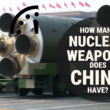How I learned to hate the Bomb
By Joelien Pretorius, February 7, 2017
The proposed nuclear weapon ban treaty might seem to have a lot in common with nuclear arms control. Both approaches, after all, acknowledge that nuclear weapons are dangerous. Both seek to reduce the number of nuclear weapons in the world. But the truth is that arms control and the ban treaty imbue nuclear weapons with very different meanings. The result is that only one approach—the ban treaty—has any hope of leading to general nuclear disarmament.
As I wrote earlier in this roundtable, I don’t see a ban treaty as a tool that can force nuclear-armed states to give up their nuclear weapons. Rather, it’s a tool that can stigmatize nuclear weapons and more deeply entrench the taboo against their use—creating the conditions for disarmament.
“To stigmatize” means to brand something (or someone) disgraceful, odious, and worthy of disapproval. Why is it so important to stigmatize nuclear weapons?
To state the obvious, nuclear weapons are massively destructive. The atom bombs dropped on Japan in 1945, which were small in comparison to the devices developed and stockpiled since, caused unspeakable human suffering. Today, a nuclear exchange could cause environmental devastation on a scale that would risk human extinction. The effects of nuclear detonations wouldn’t be contained in space and time—they would cross borders and generations. By any reasonable standard, nuclear weapons contravene international humanitarian law, which governs how wars are fought.
For these reasons, states without nuclear weapons cannot be expected to behave as if nuclear weapons were simply within the sovereign rights of nuclear-armed states. Rather, nuclear detonations and their consequences are among the pressing concerns of all humanity—of states, civil society, and individuals. This is the attitude that underlies the humanitarian initiative, a political process that has now led to the imminent negotiation of a treaty banning nuclear weapons.
Arms control, meanwhile, takes a very different approach. Useful and important though arms control may be, it underemphasizes the urgency of nuclear disarmament. Arms control recognizes in nuclear weapons the same dangers that the ban treaty recognizes, but supposes that the dangers can be brought to an acceptable level—if arsenals are shrunk, alert levels are reduced, hotlines are installed, and so forth.
Arms control depends on the actors in charge of nuclear weapons to avoid catastrophe by behaving rationally. It assumes an orderly environment and an adherence to rules. But here is the problem: Arms control does not renounce the idea that nuclear weapons—by deterring war, especially nuclear war—benefit humankind. This acceptance of nuclear deterrence is arms control’s downfall. Arms control demands that nuclear weapons not be controlled too much—otherwise, actors may come to perceive nuclear-armed enemies as unwilling to use their nuclear weapons. The result could be deterrence failure.
Arms control suffers from a dilemma. It attempts to tame nuclear weapons—but at the same time it keeps up the pretense that nuclear weapons may be used. This invites bizarre strategies such as Richard Nixon’s “madman theory,” which involves projecting an image of psychological instability to convince one’s enemies that you might use nuclear weapons. Such an approach inverts the stability and rationality that arms control usually ascribes to nuclear deterrence. Today, the madman theory is sometimes invoked to explain President Trump’s erratic views on nuclear weapons.
Even at its best, arms control takes a contradictory approach to nuclear weapons. These weapons are bad; but if we limit them, they’re good; as long as we don’t limit them too much. At its worst, arms control urges humanity—to borrow from the title of Stanley Kubrick’s film Dr. Strangelove—to “stop worrying and learn to love the Bomb.”
I don’t argue that arms control is useless. But arms control is not enough. It will not eliminate nuclear weapons from the world—and eliminating these weapons is the only way truly to safeguard humanity against their use.
The nuclear weapon ban treaty announces that humanity should worry—and should learn to hate the Bomb. Stigmatizing nuclear weapons in this way is political work. Eliminating the weapons themselves is technical work. Neither process will be easy or quick. But as with the 19th-century campaign to end slavery, the endeavor is not impossible.
Topics: Nuclear Weapons
Share: [addthis tool="addthis_inline_share_toolbox"]














